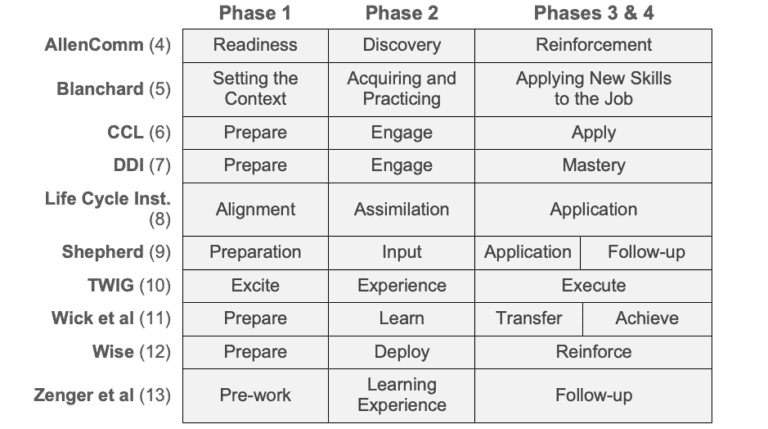
Ready-Set-Go-Show for Effective Training
In the early part of my career, I worked as National Training Manager for two retail companies. During this time, I became increasingly concerned that training (as widely implemented) had critical deficiencies and was not nearly as effective as it could and should have been.
These deficiencies included (a) participants who were ill-prepared to learn and change their behaviour, (b) training that was regarded and treated as an event, and (c) application of learning in the workplace that was not given the attention and support it deserved. As a consequence, training courses often failed to deliver the expected performance benefits and business value. In other words, the training was not effective. The question is what makes an effective training program.
Early Multi-phase Models
I subsequently enrolled for an Executive MBA and completed an in-depth research study for my thesis entitled: An Investigation Into Transfer of Training Related Factors at Shell S.A. Three training implementation models that significantly influenced my thinking were those of Leonard Nadler (1971), Saul Gellerman (1977) and John Newstrom (1980):
Each model includes multiple phases:

Nadler’s is the earliest example of a four-phase model that I discovered in my literature research.
The above models and my research findings made it clear that if training programs are to be effective, they must address a range of powerful influencing factors, especially before and after the ‘training’ provided in Phase 2.
Personal Experimentation
During the second year of the MBA program, I went into business with a friend, building a training consultancy that delivered a variety of financial acumen training programs. These addressed needs at all managerial levels as well as programs for front-line staff.
Drawing on my research, we adopted a three-phase approach to training implementation:

In working with different clients, I also sometimes referred to these phases as:

The above phases are described from a trainer’s perspective and were used to guide the design process and educate clients on the three-phase approach, especially the importance of Phases 1 and 3. You will notice that the word ‘training’ was not used for Phase 2.
Four Phase Model
Over time, I moved to a four-phase model, which was described from the learner’s perspective. One of the main reasons was to shape participants’ expectations before attending training. I also experimented with different labels/descriptors to better convey the focus of each phase:

I enjoyed considerable success in using this approach, with most ‘application projects’ producing a return on investment (based on annualised cost savings) that exceeded 100%.
Since then, I have seen numerous consulting organisations publish their own models (using a variety of names for the phases). These models all share a common aim, which is to clarify the training components necessary to positively influence performance and produce valuable business results. Here are 10 examples:

The three-phase models typically include some sharing/reporting activities in Phase 3, hence they straddle the last two phases in the table.
The Blanchard Model is actually four phases because ‘Acquiring and Practicing’ consists of two ‘stages’: Stage 2: Acquiring New Concepts and Skills, Stage 3: Practicing New Skills and Behaviours.
An Illuminating Research Project
Extensive desktop research and further experimentation led me to new insights about ‘predictability of learning’ and ‘predictability of transfer’. I subsequently decided to undertake a research project relating to the four phases.
The answers to one question in particular (which I asked many L&D specialists) had a profound effect on my perspective. The question was:
In general, what is the level of competence of participants at the end of a training event?
I used this rating scale from the Dreyfus Model of Skill Acquisition (14):

Approximately 95% of all L&D people chose (a) and (b), i.e. they judged that at the end of a training event the participants are ‘not yet competent’. When I asked managers what level they wanted from off-the-job training, most selected competent and some chose proficient. None of the managers chose (a) or (b).
With hindsight these findings are pretty obvious. There are numerous reasons why training events (including e-learning) do not deliver competence. These include emphasis on information transfer, too much content for the time available, superficial learner engagement, and insufficient or no practice.
One finding that stood out is that for many tasks competence and proficiency cannot be developed in isolation from real work. It takes considerable practice and feedback in a genuine work environment (with associated variability and contextual cues). Many managers put it this way: “The real learning happens back on the job.”
The importance of on-the-job, experiential learning in Phase 3 is reinforced by the work of people like Richard Pascale, who said that “We are all much more likely to act our way into a new way of thinking than to think our way into a new way of acting.” (15)
Implications for Training Design
Four imperatives came from my research:
- If competence cannot be achieved during off-the-job training events, then it has to be accomplished back in the workplace.
- It is necessary to define training as a journey that incorporates all four phases. In other words, training programs start with Phase 1 and only end on completion of Phase 4 (or Phase 3 if you are using a three-phase model).
- To ensure training is effective, we have to design for all the phases, not just the learning event/s. This means designing for both off-the-job and on-the job learning.
- All stakeholders (leaders, learners and learning specialists) need to understand this view of training, including their role in ensuring the success of each phase.
Transfer of learning to the workplace is still vital, but it is an integral part of a comprehensive training program, not something that happens after ‘training’ is completed.
Interpretation of the Phases
I realised that the labels used to describe the phases are particularly significant when communicating with participants and their managers. Also, that many of the existing models inadvertently encourage a misunderstanding of the second and third phase.
Take a look at the words under Phase 2 above.
- Learn, Learning, Learning Experience and other labels imply this phase is where all the learning happens, whereas it is just the ‘formal learning’ component. Learning needs to happen in Phase 3 and typically also occurs in Phases 1 and 4.
Now look at the words under Phases 3 & 4.
- Apply, Applying, Application, Transfer and other labels indicate the need to use off-the-job learning in the workplace but don’t identify the on-the-job, experiential learning that is essential to developing competence and proficiency.
In addition, the wording of the phases is not ‘sticky’ (16), which doesn’t help when communicating about training programs with people who don’t have an L&D background.
Ready-Set-Go-Show

After considering many different labels and combinations, I eventually settled on READY-SET-GO-SHOW:
- READY relates to learner readiness (or mindset); it’s about getting ready for the next three phases.
- SET indicates that the ‘learning event’ is intended to get participants appropriately ‘set up’ for Phase 3. It inherently implies that an important phase is to follow.
- GO is a strong action word and is about going back to the workplace to apply new learning, learn from application and achieve beneficial results.
- SHOW has a breadth of meaning, including ‘to present’ and ‘to prove’. It requires sharing of application and positive outcomes.
Ready-Set-Go-Show is a simple and credible description of the fundamental components of an effective training program and it is easily remembered and recalled. After all, it builds on a well-known concept from foot racing and the last two words rhyme!
Experience has shown that it is a valuable and sticky idea.
Geoff Rip
Financial Acumen & Learning Experience Design
If you are interested in learning more about Geoff and his workshops on Essemy, please visit this link.
References
- Leonard Nadler. Support Systems for Training. Training and Development Journal, Vol. 25, No. 10, October 1971, pp. 2-7.
- Saul W. Gellerman. Training and Behaviour Change. Training and Development Journal, Vol. 31, No. 2, February 1977, pp. 3-5.
- Melissa S. Leifer and John W. Newstrom. Solving the Transfer of Training Problems. Training and Development Journal, Vol. 34, No. 8, August 1980, pp. 42-46.
- Microlearning Techniques: Driving Results by Empowering Learners. 2017. Referred to as ‘learning lifecycle stages’ by InSync Training LLC.
- The Ken Blanchard Companies. How to Maximise Your Training Investment: A Process for Closing the Learning-Doing Gap.
- Diane Reinhold, Tracy Patterson and Peter Hegel. Make Learning Stick: Best Practices to Get the Most Out of Leadership Development. Center for Creative Leadership. 2015.
- Evan Sinar. DDI Webinar: What 15,000 Assessments Spanning 300 Organizations Say About Leader Readiness. May 2016.
- Life Cycle Engineering. How to Ensure Training Changes Behavior. From the ACMP Global Conference Workshop: Learning is Change. Change is Learning.” https://www.lce.com/How-to-Ensure-Training-Changes-Behavior-1267.html
- Clive Shepherd. PIAF – The Ideas Adventure. 19 December 2013. http://clive-shepherd.blogspot.com.au/2013/12/piaf-ideas-adventure.html
- Brent D. Peterson. Current Learning Practices Don’t Work: The 4E Learning Model Does. Downloaded from www.partnersinlawenforcement.com [defunct). TWIG = The Work Itself Group.
- Calhoun Wick, Roy Pollock and Andrew Jefferson. The Six Disciplines of Breakthrough Learning: How to Turn Training and Development into Business Results. 2nd Edition, 2010.
- Gary Wise. The PDR Learning Continuum – Using a New Design Framework. Living in Learning Blog. 14 August 2009.
- Jack Zenger, Joe Folkman and Robert Sherwin. The Promise of Phase 3. TD Magazine, January 2005, pp. 30-35.
- Nat Eliason. The Step-by-Step Guide to Go from Novice to Expert in Any Skill. 26 June 2017. https://www.nateliason.com/blog/become-expert-dreyfus
- Richard T. Pascale, Mark Millemann, and Linda Gioja. Changing the Way We Change, Harvard Business Review Vol. 75, No. 6, 1997, pp. 126-139.
- James Le. The 6 Principles to Make Your Ideas Stick. Medium, 18 December 2017. https://medium.com/constraint-drives-creativity/the-6-principles-to-make-your-ideas-stick-91a17229c949
Copyright
The four-phase Ready-Set-Go-Show Model was created by Geoff Rip. Non- commercial use of the diagram and name is permitted under a Creative Commons CC BY-NC-ND 4.0 Licence.